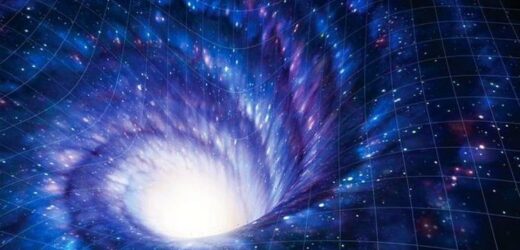Brian Cox discusses the 'disturbing' nature of black holes
We use your sign-up to provide content in ways you’ve consented to and to improve our understanding of you. This may include adverts from us and 3rd parties based on our understanding. You can unsubscribe at any time. More info
The discovery was made inside a cluster of stars in the Andromeda galaxy, known as AKA M31. Experts studied changes in light to identify a huge region of spacetime almost 100,000 times the mass of the Sun. It places it in the “intermediate-mass” bracket of black holes – both elusive and highly sought by astronomers to answer the universe’s greatest questions.
The team of astronomers, led by Renuka Pechetti of Liverpool John Moores University, wrote: “In this paper, we use high-resolution mass models and kinematics to present the detection of a ~100,000 solar-mass intermediate-mass black hole (IMBH) with greater than 3-sigma significance.”
Their work has been posted to preprint server arXiv, and accepted for publication by the American Astronomical Society (AAS).
Black holes are formed when massive stars collapse at the end of their lives and can continue to grow by absorbing and merging with others.
This interaction has been observed for decades and scientists use it to identify their presence, as radiation is given off as visible light across space.


Most black holes can be categorised by two mass ranges.
There are the stellar-mass black holes, up to around 100 times the mass of the Sun; and supermassive black holes, which start at a low range of around a million times the mass of the Sun.
In the middle is a range classified as intermediate, and while their detection is helping provide the “missing link” to the universe’s secrets, it is extremely rare.
To date, the number of IMBH detections remains incredibly low.
Without more intermediate-mass black holes, scientists struggle to resolve how two wildly different mass regimes can coexist.

A solid population of black holes in the intermediate-mass range could help us bridge the gap, proffering a mechanism whereby stellar-mass black holes can grow into behemoths.
This is why a cluster of stars in the Andromeda galaxy, known as B023-G078, is of such interest to scientists.
B023-G078 is the most massive such star cluster in the galaxy, a roughly spherical, gravitationally bound cluster of stars clocking in at 6.2 million solar masses.
One way that these clusters can form, according to models, is when one galaxy subsumes another.
And this is what the team believes has happened with B023-G078.
They studied the metal content of the cluster, based on subtle signatures in the light it emits, and determined that it has an age of about 10.5 billion years.
DON’T MISS
Palaeontologists stunned by major twist in find of four-legged snake [REVEAL]
Putin’s plot ‘dead in water’ a Germany slams breaks on gas [INSIGHT]
Sea level warning as England sinks into ground: ‘Significant’ [REPORT]


Then, they studied the way the stars move around the centre of the cluster to try to calculate the mass of the black hole that should be within.
This returned a result of around 91,000 solar masses, which constitutes around 1.5 percent of the mass of the cluster.
The experts added: “We favour the presence of a single IMBH given the other indications that B023-G78 is a stripped nucleus, as well as the apparent compactness of the dark component,” they wrote in their paper.
“Higher spatial-resolution data would give improved constraints on the nature of the central dark mass and should be a high priority in the forthcoming era of extremely large telescopes.”
The team’s paper is available on arXiv, and will be published by the AAS.
Source: Read Full Article


